Big Plans For and Against Big Oil
Air Date: Week of August 4, 2017
The Dakota Access pipeline under construction. (Photo: Lars Plougmann, Flickr CC BY-SA 2.0)
North American oil and gas producers are rushing to build new pipelines as part of bid to gain more power in the international oil and gas markets, but they are running into fierce opposition at home. Reporter Sandy Tolan spoke with key players in the controversy, including residents of Louisiana'a Bayou country, where the hotly debated Bayou Bridge pipeline is still in the planning phase.
Transcript
CURWOOD: It’s Living on Earth, I’m Steve Curwood.
In the early spring last year Native activists rode their horses through the snow to the edge of the Cannonball River on the Standing Rock Sioux reservation, pledging to kill the “black snake,” the nearly 1200 mile long Dakota Access Pipeline –“DAPL.” Well, that fight was lost, as in May thousands of barrels of fracked crude oil began flowing through that pipeline, heading to a terminal in Illinois, and then down toward the U.S. Gulf Coast.
But Native and climate change activists say the struggle against DAPL was just one battle in a much longer war, with a dozen more Standing Rocks on multiple front lines across America, as companies race to lay pipelines as quickly as possible. Campaigners warn the U.S. is becoming a “petrostate.” U.S. climate commitments they say, and the very health of the planet, are at stake. Living on Earth contributor Sandy Tolan spent months investigating the new oil wars. Here’s his report.
[POLICEMAN ON BULLHORN, CROWD SOUNDS]
TOLAN: For 10 months, thousands of overwhelmingly peaceful protesters stood on the front lines at Standing Rock. They endured tear gas, rubber bullets, hypothermia, and vilification by the police and local media.
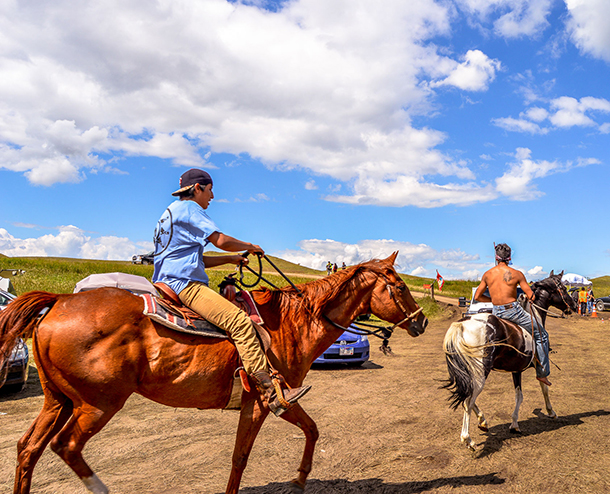
Two Standing Rock demonstrators take to horseback as part of the Standing Rock demonstrations that peaked in 2016. (Photo: Robert Wilson)
MAN ON BULLHORN: First of all, we need to know, these protestors that are here, right now, eighty-five percent of them, based on the arrests so far, are from somewhere else. OK? They’re not from North Dakota. And if we follow the money of who’s paying them to get here, I want an investigation not unlike we do in a drug crime, not unlike we do in some terror, because they are terrorists...
OTHER MAN ON BULLHORN: You need to get out now…
TOLAN: In my five trips to North Dakota over the fall and winter, I was always struck by the intensity of the police and private security companies’ response -- the dog attacks, the hoses dousing protesters in sub-freezing temperatures, the metal detention cages modeled on dog kennels, the numbers scrawled on the forearms of the people they arrested. These seemed like tactics from another era or another country. I wondered why North Dakota was so intent on not losing the fight over the Dakota Access Pipeline.
[HELICOPTER]
POLICEMAN ON BULLHORN: If you do not comply, you will be arrested for violations of North Dakota laws. Please disperse now.
TOLAN: Turns out, officials here were protecting a grand plan worth tens of billions of dollars. In that plan, the Dakota Access Pipeline, DAPL, is North Dakota’s linchpin. It allows a glut of fracked oil from the massive Bakken formation to flow southeast toward the US Gulf Coast. Bakken oil is part of, what boosters call, the “North American petroleum renaissance.” The US is now the world’s third largest producer of crude oil, pumping more than Iran and Iraq combined.
North Dakota Republican Congressman Kevin Cramer says, that means opportunity.
CRAMER: We have the potential to produce all we need and then some.
TOLAN: Cramer is a champion of DAPL and a climate change skeptic.
CRAMER: I view us as a North American energy block that rivals, if not exceeds, the global market potential of OPEC.
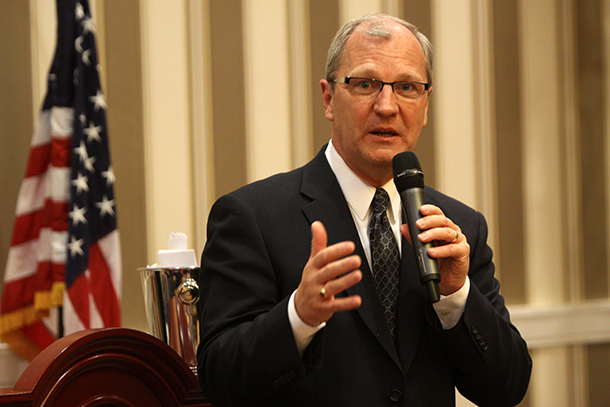
Republican Congressman Kevin Cramer is a proponent of pipelines as a means of transporting crude oil. (Photo: Gage Skidmore, Flickr CC BY-SA 2.0)
TOLAN: But if that’s to happen, Cramer says, North Dakota producers can’t keep shipping fracked oil by expensive rail to the east coast. They need more efficient means.
CRAMER: And that's where the Dakota Access Pipeline comes in. That infrastructure has to, of course, involve moving oil to the coasts and having export terminals and all that.
TOLAN: “Export terminals.” You heard the Congressman right. Kevin Cramer says the Dakota Access Pipeline will carry oil for export.
CRAMER: So, yeah, I think Bakken crude is destined for the world.
TOLAN: Yet DAPL, Keystone XL, and other controversial projects were justified in part in the name of American “energy independence.” Lorne Stockman of the watchdog group, Oil Change International, says that’s a line of bull.
STOCKMAN: The oil and gas industry is sort of wrapping itself in the flag and talking about energy independence, when actually what they're doing is turning the country into a resource colony for export of oil and gas.
TOLAN: So, the pipeline company Energy Transfer, backed by North Dakota officials, police, and the National Guard, fought that huge battle at Standing Rock, in large part so that US crude oil could leave the country.
CRAMER: We now get to play in the global marketplace.
TOLAN: For 40 years that was illegal. During the Arab oil embargo, Congress imposed a ban on crude oil exports. Only American oil destined for Canada could leave US shores. But, with all that fracking in North Dakota and Texas, the shale oil revolution changed the game completely.
HEITCAMP (on CNBC): And so North America is going to become the energy powerhouse for the world...
TOLAN: And Senators like North Dakota’s Heidi Heitcamp, a Democrat, started showing up on the business talk shows, along with oil executives, saying it was time to turn American oil loose.
HEITCAMP (on CNBC): And if you don’t allow the exports of this oil, they’re going to re-invest someplace else where they can market their oil.
TOLAN: And so in December 2015...
NEWS ANCHOR1: There is a big move in Washington as Congressional leaders have agreed to lift the nation’s 40-year old ban on oil exports...
TOLAN: Now, more and more, exhaust from American crude oil is destined to spew from tailpipes in Amsterdam, Beijing, Tokyo, even Caracas. Every day this February nearly 300,000 barrels of American oil went to China.
NEWS ANCHOR2: China became the biggest buyer of US crude in February. The country imported over eight million barrels…..
TOLAN: Ironically, all this is happening as demand for oil in the US and other Western countries is flattening. You may wonder, then, why there’s a massive buildout of tens of billions of dollars in pipelines, oil storage tanks and export terminals. Perhaps that’s because of skyrocketing demand in the developing world.
Lena Moffitt, director of the Sierra Club’s Beyond Dirty Fuels campaign, says the two go together.
MOFFITT: I think that they’re playing the long game, in that they are teeing things up to ensure that not just the United States, but the globe, stays reliant on oil for as long as possible.
TOLAN: Oil companies have seen the writing on the wall, Moffitt says, and they’re moving as quickly as they can.
MOFFITT: To lock in continued demand for product via this infrastructure. The industry is in, you know, a race to secure the export terminals and the pipelines that will get these fossil fuels to our coasts as fast as possible.
TOLAN: And yet, just as DAPL is but one big pipeline amidst a sea of new infrastructure, so was Standing Rock only one battle in a long war. Activists are taking to the front lines from Vancouver to Maine, from Minnesota to Oklahoma to Louisiana’s bayou country.
FOYTLIN: In these troubling times, where we're seeing such an assault upon water and earth, on our communities, I don't feel like anyone has the opportunity to slack or lay off.
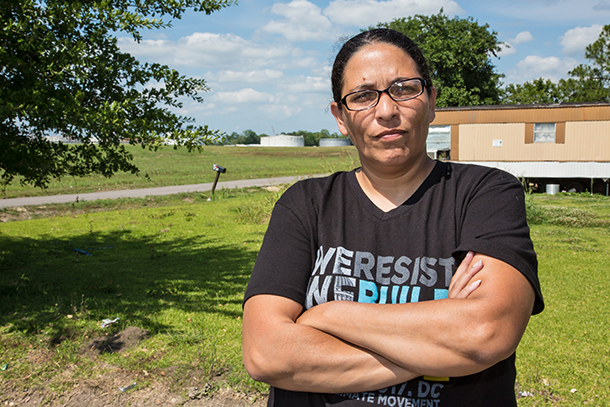
Cherri Foytlin on Burton Lane, in St. James Parish, where the Bayou Bridge Pipeline will end if built. The oil storage tanks in the background are close to locals’ homes. (Photo: Julie Dermansky / Reveal)
TOLAN: I’m heading into Bayou country with Native activist Cherri Foytlin in her SUV, rolling past gleaming white cylinders -- crude oil tanks – part of that massive new infrastructure. Foytlin is raising six kids in a small town 150 miles west of New Orleans. But as state director of the Bold Alliance, she’s spending a lot of time on the road these days, fighting pipelines, especially the proposed Bayou Bridge.
FOYTLIN: This is like the continuation of assaults against our communities. We have so many pipelines in our state and so many accidents and so many leaks.
TOLAN: The Bayou Bridge would be built by Phillips 66, Sunoco, and Energy Transfer.
FOYTLIN: …Which is the same corporation who had committed human rights violations in Standing Rock in North Dakota. Their plan is to put in a pipeline that runs from Lake Charles to St. James across 11 parishes, including my own parish, where I live, and 700 bodies of water right down there in south Louisiana and the wetlands.
[SLAMMING CAR DOOR AND FOOTSTEPS]
TOLAN: Foytlin pulls up where a gravel road meets the softly lapping waters of a lake. We walk to the water’s edge.

Wetlands near the route of the proposed Bayou Bridge pipeline south of Lake Charles, Louisiana. (Photo: Karen Savage / Reveal)
FOYTLIN: We’re standing on the edge of some beautiful wetlands. You can see birds. That’s a wood duck flying over. I saw a pelican here just a few minutes ago.
TOLAN: In the distance refineries belch smoke and orange flares.
FOYTLIN: The Bayou Bridge pipeline is going to go right through this body of water, right through those wetlands right there.
TOLAN: The Bayou Bridge recently cleared one regulatory hurdle, and now it’s closer to reality. Despite the complex social dynamics between Louisiana’s oil industry workers, fishermen, and local communities, energy has generally held sway here. Yet, back in the car, Foytlin tells me that in the age of Trump and Standing Rock, something has changed. Not long ago, two or three people would show up to protest a new energy project. But now...
FOYTLIN: We had a solidarity action for Standing Rock and several hundred people showed up, and that's, that’s historic for us. Yeah, we had two hearings, and in one case we had about 400, 450 people. We're definitely seeing a shift in awareness, in consciousness, and in people taking action.
TOLAN: It’s the same story at dozens of pipeline battles across the country. Activists, inspired by Standing Rock and spurred by Trump, are mobilizing. Sierra Club Washington lobbyist Athan Manuel says, that’s a big thing.
MANUEL: These pipeline fights are really, really important because we need to cut off the economies of scale for them, and stopping those pipelines is one way to do it.
TOLAN: But the economy of scale of the American oil renaissance, and the power behind it, is huge. So much more oil is pumping out of US wells, compared to just 10 years ago, that the very flow of it has reversed direction.
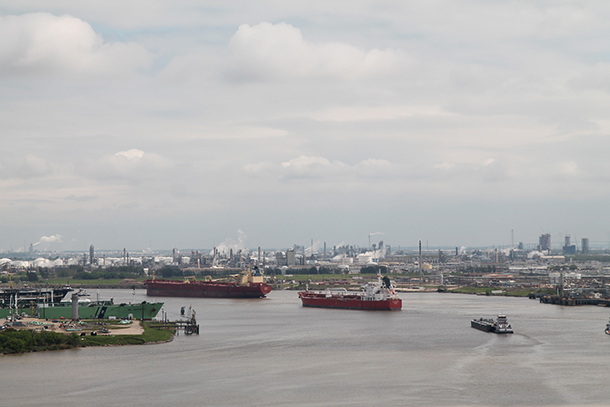
Existing industry dominates the skyline in Lake Charles, Louisiana. (Photo: Karen Savage / Reveal)
BRAZIEL: So, you want to know how crude oil moves. Most of the crude oil in the United States moves right there.
TOLAN: A silver-bearded Texan in jeans and cowboy boots leans over a table in the high-rise conference room of his company, RBN Energy.
[SOUND OF UNROLLING A MAP]
BRAZIEL: There was a time when a lot of crude moved up from this area.
TOLAN: Rusty Braziel unfurls a giant map labeled “US GULF COAST CRUDE OIL INFRASTRUCTURE.” He traces his finger from Louisiana toward Cushing, Oklahoma, the “pipeline crossroads of the world.”
BRAZIEL: With all of the production that kicked in, in both Canada and in North Dakota, and now a lot of that crude moves back down this way.
TOLAN: His finger reverses, moving back toward the Gulf, and all its new terminals and storage tanks. But Braziel’s a bit of a contrarian. He doesn’t think much of this oil is leaving the country any time soon. For one thing...
BRAZIEL: We still import about seven million barrels a day, net imports. Now, we have to bring in a barrel for every barrel that goes out.
TOLAN: So, he’s skeptical of all the export talk. For starters, it has to make economic sense.
BRAZIEL: So, it costs me money to ship it there, right? So if I put it in a ship here, and I get the same thing for it there that I could have sold it for here, but I had to pay $2 to get it there, why would I do that?
TOLAN: In the year after the export ban ended, Braziel shows me on his laptop, exports hardly ticked up at all.
BRAZIEL: It’s nothing. It’s nothing. Nothing happened.
TOLAN: But more recently buyers in Japan, Singapore, and China are beginning to pay more for American oil than producers can get back home, especially after OPEC cut production last year. This year for the first time US exports topped a million barrels a day, double that of a year ago. The American petrostate is flourishing, just as the planet is warming.
[DRUMMING]
TOLAN: And the cherry blossoms along the National Mall are blooming earlier and earlier.
GEMMILL: The very ground we walk on is melting beneath our feet.
TOLAN: Native activist Faith Gemmill sits on a patch of grass on a mild March afternoon, in the shadow of the Washington Monument. She’s come with thousands of others to stand with Standing Rock and to move on to other struggles, for example, in her native Alaska.
GEMMILL: There’s actually communities that are on the coastline that need to be relocated immediately. It’s an urgent situation because the ice melting has allowed the erosion of the coastlines. And that's going to be the reality of other coastal communities anywhere in the US eventually, if we don't raise the profile of catastrophic climate change.
TOLAN: Gemmill is part of the Indigenous Environmental Network. She sits beside six large teepees across the mall from the Capitol building. Activists have been lobbying sympathetic senators like former Democratic presidential candidate Bernie Sanders.
[VOICES IN A CROWD]
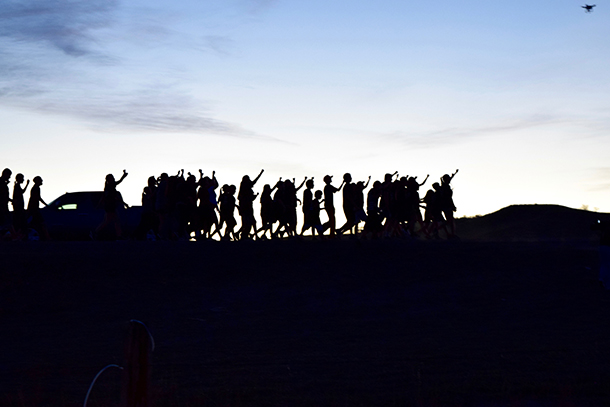
A group of youth demonstrators marching from Cannonball River to the Oceti Sakowin Campground. (Photo: Jacqueline Keeler)
TOLAN: And now Oregon Democratic Senator Jeff Merkley ducks into one of those teepees, and in his grey pinstripe suit plunks himself on the dirt. He sits in a circle among two dozen natives, all with their own stories of energy disasters on their homelands. Dallas Goldtooth was a leader in the battle against DAPL.
GOLDTOOTH: A lot of us are coming here to this camp that has been spearheaded by this fight against Dakota Access pipeline. But it’s not just one pipeline we're fighting against. It's not just Standing Rock. It's this global effort to keep fossil fuels in the ground and build really good solutions.
TOLAN: Merkley sits and listens for half an hour. He looks around the teepee, talking about his own “Keep It In the Ground” bill for federal land.
MERKLEY: By 2050, we must completely replace our fossil fuel energy economy with clean and renewable energy.
TOLAN: But, he says, not much will happen in Washington any time soon. The fight is local, and it’s long term.
MERKLEY: The fossil fuel industry largely owns Congress. They've invested bazillions of dollars in campaigns to control the Senate and the House. So, our response to that has to be to bypass the federal government, go directly to every local organization and say, “Let’s own this problem at the grassroots level, and let's act.” That is a grassroots strategy because we cannot wait for the US government.
TOLAN: Outside the teepee, I see a young Navajo woman I’d met at Standing Rock. Vanessa Dundon, who goes by Sioux Z, was badly injured during the clashes with police when she was shot in the eye by a tear gas canister. Since then, she tells me, she’s had three surgeries, but still has only 10 percent vision in her right eye.
SIOUX Z: And I still have a few more surgeries.
TOLAN: But Sioux Z is more interested in talking about where the fight will go from Standing Rock.
SIOUX Z: It was really hard. Because we all fought so hard, but we’re still here, and we spread the fire.
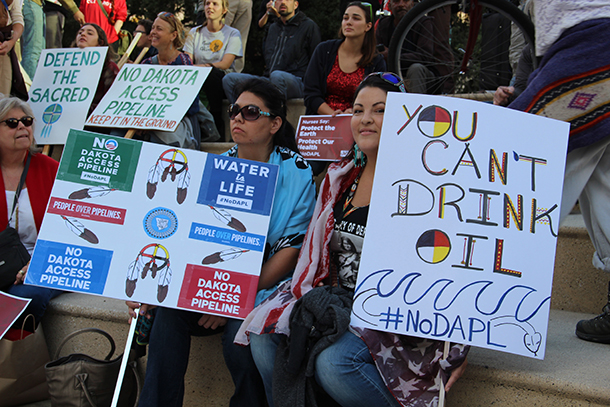
Local demonstrations against the Dakota Access Pipeline sparked protests in Oakland, California, and dozens of other places around the U.S. (Peg Hunter, Flickr CC BY-NC 2.0)
TOLAN: She means that literally. Embers from the sacred fire in Standing Rock are being carried to other pipeline battles across the country, where they light up new struggles.
SIOUX Z: I've been to a few pipelines since I’ve seen you. I went to Texas. I went to the Pilgrim Pipeline up in New Jersey, and the one in Iowa just started. I want to go check them out too before I head back to Florida, where I've been to two of the camps there. I’m planning on going to Oklahoma. They're going to light their fire next week.
[FOOTSTEPS AND CROWD NOISE IN THE BACKGROUND]
TOLAN: The fire has also spread, if only symbolically, to a white Southern woman on a lonely six acres of land in Louisiana’s bayou country.
[WALKING]
ROSINSKI: We are walking in my backyard.
TOLAN: Hope Rosinski, a single mom, owns a home in the path of Energy Transfer’s Bayou Bridge pipeline, the last leg that begins with the Dakota Access, 15 hundred miles north.
ROSINSKI: But this is basically right here where the Bayou Bridge wants to come through.
TOLAN: Rosinski says she won’t let the pipeline company cross her land in Louisiana’s Acadia Parish on its way to an oil terminal in St. James.
ROSINSKI: This is the right of way that pipeline came through -- I guess the end of ’15 -- and I've been battling them for the past year. They've offered me money for an easement. I don't want them to come through.
TOLAN: Representatives of Energy Transfer have tried to cajole Rosinski with friendly talk, entice her with money, and threaten her with eminent domain. Finally, in March the company served her with a “petition for expropriation.” Still she’s not budging.
ROSINSKI: And I see things differently. I was very naive as to what goes on with these oil companies, and I don't want any part of it. I think that human life is much more important than a dollar. We can be okay without all that oil.
TOLAN: But the America First energy players are in power now, targeting what they say is $50 trillion in untapped petroleum. And so all that oil will flow through all those pipelines, toward all those export terminals, no matter how hot the planet gets. Unless, of course, activists like Hope Rosinski can find ways to stop them.
ROSINSKI: I’m just waiting. Hoping and praying that we win. It’s time.
[SOUNDS OF THE OUTDOORS]
TOLAN: For Living on Earth, this is Sandy Tolan.
Links
The Times-Picayune: “With Bayou Bridge Pipeline, Louisiana again weighs oil, environment”
Indigenous Environmental Network
Army Corps of Engineers: About the Bayou Bridge Pipeline
Bold Louisiana Bayou Bridge Updates
An LOE report from Sandy Tolan about the Dakota Access Pipeline
Reveal Center for Investigative Reporting | More from Tolan on Pipelines
Living on Earth wants to hear from you!
Living on Earth
62 Calef Highway, Suite 212
Lee, NH 03861
Telephone: 617-287-4121
E-mail: comments@loe.org
Newsletter [Click here]
Donate to Living on Earth!
Living on Earth is an independent media program and relies entirely on contributions from listeners and institutions supporting public service. Please donate now to preserve an independent environmental voice.
NewsletterLiving on Earth offers a weekly delivery of the show's rundown to your mailbox. Sign up for our newsletter today!
 Sailors For The Sea: Be the change you want to sea.
Sailors For The Sea: Be the change you want to sea.
 The Grantham Foundation for the Protection of the Environment: Committed to protecting and improving the health of the global environment.
The Grantham Foundation for the Protection of the Environment: Committed to protecting and improving the health of the global environment.
 Contribute to Living on Earth and receive, as our gift to you, an archival print of one of Mark Seth Lender's extraordinary wildlife photographs. Follow the link to see Mark's current collection of photographs.
Contribute to Living on Earth and receive, as our gift to you, an archival print of one of Mark Seth Lender's extraordinary wildlife photographs. Follow the link to see Mark's current collection of photographs.
 Buy a signed copy of Mark Seth Lender's book Smeagull the Seagull & support Living on Earth
Buy a signed copy of Mark Seth Lender's book Smeagull the Seagull & support Living on Earth

